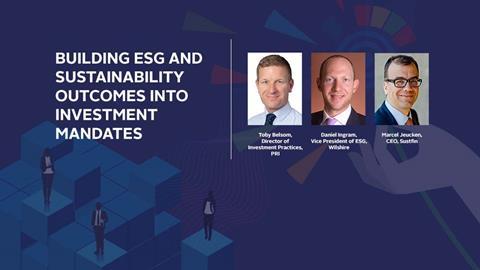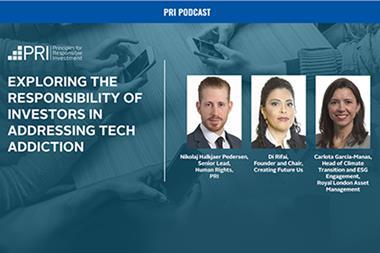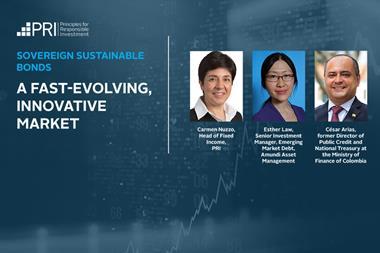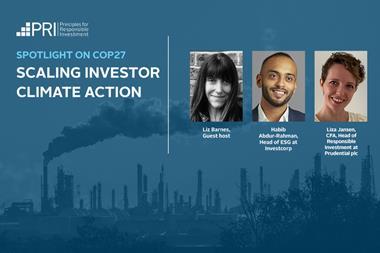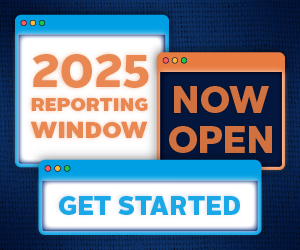In this discussion, our guests explain why integrating ESG and sustainability outcomes into mandates is important from an Asset Owner perspective, and share experiences of working with Asset Owners trying to put this into practice. While segregated mandates are often the preserve of large AOs, the dialogue highlights tools available to smaller AOs who invest in co-mingled or pooled funds.
Find the podcast transcript here
Building ESG and sustainability outcomes into investment mandates
With Toby Belsom, Director of Investment Practices, PRI, Daniel Ingram, Vice President of ESG, Wilshire and Marcel Jeucken, CEO, Sustfin
Note: The Principles for Responsible Investment podcast is designed to be heard. If you are unable to do this, this transcript offers an insight into the episode.
Transcripts are generated using a combination of speech recognition software and human transcribers, and may contain the occasional error. Please check the corresponding audio before quoting in print.
Subscribe to the channel via Apple podcasts, Spotify, or wherever you listen to your podcasts.
Toby Belsom
Thanks for joining us on the next installment of PRI podcast. This one will build on lots of work PRI team, helped by our asset owner advisory committee has been doing in relation to the selection, appointment and monitoring of asset managers. More specifically, this podcast will discuss the integration of ESG issues and beneficiary values into investment mandates. We’ve got two great speakers from both sides of the Atlantic - Daniel Ingram, a VP of ESG at Wilshire, one of the leading US investment consultants and Marcel Jeucken, CEO of Susfin, specialist, ESG consulting firm, based in the Netherlands. Both speakers have extensive practical experience of advising asset owners in exactly this area at PGGGM and BT pension scheme. My name is Toby Belson, I’m Director of investor practices at PRI and I’ll be moderating this session.
Daniel, maybe turning to you first. What do you think integrating ESG and comes into mandates is so important and what’s your experience of working with asset owners trying to put this into practice?
Daniel Ingram
Well, thanks Toby. It’s really nice to talk to you today. Great to be part of this look. I mean, I think you’re absolutely right. We’re, you know, 15 years in, in my experience speaking to hundreds of asset owners a year, and you know, there’s very much this focus now on, for asset owners putting ESG into practice. It really is this kind of fundamental shift from, you know, asset owners starting to ask the question about to what extent ESG issues are financially material. And now they want to know how to efficiently integrate ESG into their investment decisions and whether there’s any low hanging fruit to do that. And I really do think that the investment mandate is part of that sort of low hanging fruit as it were.
Toby Belsom
Marcel, I know you’ve worked with PRI extensively in terms of developing our thinking for signatories on outcomes. Just what’s your experience sitting in it from a European context on outcomes and investment mandates.
Marcel Jeucken
Yeah. Thanks Toby and good to be here also as well. And, and also with Daniel and, you know, we all go back long. And you know, we’ve gone, gone on a very long journey in terms of integrating ESG in various spaces. And I think this is crucial work that we do on investment mandates. And it’s very good that we not just focus on the ESG risks and opportunities, so to speak on the investment portfolio. But what we increasingly also see is a focus on outcomes in terms of what we as investors, our investor actions do in real work impact, real world outcomes in the world. And as a matter relevant for the entire investment portfolio, not just for tiny bits which might be called or labelled impact investments but for every part of the allocation of asset owners and increasingly this is being seen by many asset owners at least in the part of the world I’m in. And that’s also the project that the PRI worked on last year – a report called Investing with SDG outcomes focused on basic, not just on that perspective or how sustainability or the world, so as we speak impacts investment portfolios from risks and opportunities perspective, and that’s materiality lens, the single material lens, but also how investor actions actually impact the world. And that’s important from a responsibility perspective. If you think about pension funds, for example, that have investment horizons up, or, you know, fund horizons up to 70 years or longer - they, they care about not just the risk and, and opportunity store investment portfolio, but also to how they contribute to what kind of world their beneficiaries will in. And increasingly we see that up in policies or asset owners saying it’s not just about having a good financial return, but also a good societal return. And this impact, this focus on outcomes is increasingly being picked up and is increasingly now also being part of attaching that to investment band aids. So that’s a crucial part, as a next wave, I would say in terms of our responsible investment development globally,
Toby Belsom
Kind of following up from that Marcel with COP 26 and the rapid growth of the Net Zero asset owner Alliance, you’ve seen now asset owners make an increasingly broad range of climate commitments. What are the main tools to put those into actions, our reports, and the one that you refer to just then talks about the investment mandate, being a really underutilised tool in that function, why is this? and how do you think it can be rectified?
Marcel Jeucken
I think it’s a broader question, I think, well to do the first part around climate and, and outcomes I think investors increasingly are seeing, and that’s why we see such a huge uptake on that zero is that the outcome they can have in the world is ultimately also in a feedback loop, a risk and opportunity that a portfolio. If we don’t solve the climate crisis, so to speak you’ll end up with portfolios that have stranded assets, are in the water. And so from a policy perspective, it’s quite crucial that we have to focus those outcomes. And it’s great to see so much uptake on the net zero. What it leads to, is that a question, how should we tweak our existing mandates or set new mandates in terms of either reducing the carbon footprints or investing in the energy transition that’s on the table?
So these commitments will trigger what this report that Willshire and PRI have worked on in terms of both the existing mandates. How can you attach higher expectations to something you already agreed in terms of especially climate, but it can also be another stuff. But also, in terms of, how can you set new mandates? And that’s where we see a proliferation of ideas not just coming from asset managers but from asset owners providing solutions. And I think that’s the good thing, you know, once we all get these commitments in and that area is an important development, it will lead to the asset management industry to think about how they can come up with solutions that integrate that perspective. So, to get better climate outcomes, so to speak, or have less climate risk in your portfolio, or have your portfolio more moving towards the new economy, so to speak the carbon neutral economy. So, this mandate perspective is crucial in getting those policy commitments done
Toby Belsom
Daniel, as we’re working through the development of this report, or from your experience working with other asset owner clients. I wonder whether you’ve got anything to add there about transposing climate commitments into action, through investment mandates.
Daniel Ingram
Right. We’re trying to be very clear about what kind of actions asset owners can take. Again, coming back to this idea of sort of low hanging fruit. We sketched out four actions, the first being climate risk assessment, second governance preparations, the third evaluating the options, and then fourth. And I think this is really relevant for the investment mandate is holding agents to account. And I, so in this case, you know, the fourth step in terms of the agents, I think they were very much talking about this really relationship between the asset owner and the investment manager. And to your point, I think, you know, we really found drafting this report that the mandate itself, maybe being underutilised, because there’s often minimal turnover. A lot of these investment mandates that asset owners have put in place have been there for many years, you know, certainly over five years and that relationship has formed over time.
So it’s not always as simple as sort of, okay, how are we going to reach net zero? We’ll redesign, you know, reissue every investment mandate for our entire asset allocation with climate risks, for example, front and center in that design and selection process. So what we’re really finding, I think particularly as part of this rapport is that probably the low hanging fruit is actually, like we’re talking about focusing on the sort of resetting the expectations with the manager around the existing mandates. And so really that I think starts with a series of questions, in terms of holding managers to account asking them while we’re talking about climate, you know, can you provide example of security or asset by sell decisions you know, where climate was material to those decisions?
You know, I wouldn’t be surprised if asset owners start and I think we’re seeing this a little bit in Europe, start drafting specific sort of climate expectations to their managers. And so, you know, maybe as some of those new mandates start to become issued, you might see as gating questions, asset owners start to say, you know, have you signed up to a net zero target to the manager? Have you issued an interim net zero target? So, we may start to see climate being part of the kind of core minimum qualifications to start to be awarded some of these mandates. So, I think we will see a blend of the new and the existing mandates when it comes to climate risk management.
Toby Belsom
Thanks Daniel, but Marcel, what’s your kind of European perspective on that.
Marcel Jeucken
It’s about the opportunities of the unity transition, ensuring that the managing also invests in that, so that you reap some part of that. And in terms of your overall difference and diversifying nature of your asset base, you’re also picking up on those new assets in these new opportunities that the transition and around climate will shape those portfolios. But also from a perspective of outcomes you can actually then say, this is where we want to move. And so, your net zero ambition, for example, has to be brought back to methodology that you actually say both existing and you, this is where we want to get. And so, raising those expectations with short term objectives. So not just to 20, but to 30, 40, 50. Then also in terms of what we want to achieve, that’s not just for a risk and opportunity perspective, that can be important, that lands can be important, but can also be very important from an outcome perspective, but that’s what we increasing have seen.
There’s one other note I wanted to make. Yes, the focus should be to a large extent also on existing cause that’s where most of the and assets are, but especially in private markets, money come comes back. And so, you’ll have a lot of new mandates as well. So as an asset only, you should really think also about new mandates. Some funds are really growing, so they will have new mandates. It’s not just that the bulk is just existing but it’s important to make that distinction, but also to learn from both sides to what you can actually achieve and you, and what you can then raise expectations in existing, but also what you get back from existing, what you can’t achieve in terms of your expectations, how you can then try to tweak that into something that can work in new. And so, taking the holistic perspective on both and understanding the difference between and us crucial
Toby Belsom
Daniel, segregated mandates are often seen as the preserve of larger asset owners. What tools are open to asset owners who invest in commingled or pooled funds?
Daniel Ingram
So I think the main two tools that available to asset owners that invest in pool or co-mingled funds, which maybe weren’t available to them a few years back. Firstly, around proxy voting and secondly, around collaborative and engagement or collaborative stewardship. So, on proxy voting, something that asset owners have long been calling for is the ability to direct proxy votes for themselves rather than take the index or managers proxy voting policies. And we’ve just had in Q3 of 2021, one particularly big passive index manager announced that clients, asset owners invested in their co-mingled or pulled funds can choose from a menu of third party proxy voting policies, or they can vote directly on select resolutions or companies, or they can continue to use that index providers, proxies.
So that’s a real change and we expect potentially other index managers to follow suit to provide that flexibility for then asset owners of all sizes to be able to have much more direction over their proxy votes, which I think is a real game changer. And then secondly, around collaborative engagements, things like Climate Action 100+. You know, to me, this is the most successful, most well organised clearest, you know, target goal orientated, collaborative engagement that’s emerged in the past few years, with real world impacts on emissions reductions. And you know, joining things like climate action 100 plus are available to those asset owners invested in co-mingled or pulled funds, free to join. And we expect other, sort of well resourced, um, well targeted collaborative engagements to be available to those asset owners, investing in co-mingled or pool funds.
Toby Belsom
Marcel, turning to you. I wonder if you had any specific examples of this in action, especially in the selection of pool funds
Marcel Jeucken
On the selection side of pooled structures, your influence is of course less than your other accounts, but you can still do a couple of things. You can still set your expectations and try to find those managers, those structures that actually live up to your policy objectives. That’s one thing - that’s for example, where we’ve seen as a Dutch example, and it’s focused on outcomes. In the Dutch market, we had an initiative, we have had to basically avoid or mitigate negative impacts from companies on OECD guidelines for multi-national corporations, UN guiding principles on human rights, and actually contribute that of course, to segregated structures that’s much easier, but by working together as a Dutch, asset owner base base, all pension funds have basically come together to set up, set up their approach to this they’ve set their expectations to awards, also pull structures and what we is also structures rethink some of their offerings. And this is maybe just Dutch and well, the Dutch market is big, but it’s, it’s still just Dutch.
What the SFDR does, then it’s the same. They talk about same underlying do know harm, do significant harm principles, which are, again also the OECD guidelines and kin principles and that asset managers and have to report to it also pull structures, ensuring also those asset owners that have objectives towards those outcomes, those human right outcomes for example, we’ll see solutions being brought to market simply also because there’s increasing standardisation in the industry. So, while you might not be able to influence on your own the exact description of what’s being done in the full, full structure, the increasing initiatives where asset owners collaborate or while also regulators coming is enabling all structures that actually offered solutions to the objectives of venture funds and asset owners.
Toby Belsom
In our report, we talk about the importance of having a focus on sustainability outcomes through investment mandates. Can you explain what we mean by this and, and why it’s increasing relevance to asset donors?
Marcel Jeucken
Well, if you think about the perspective I’ve described where asset owners have focused initially very much on, you know, risk and opportunity of what sustainability in the real world actually means for the investment portfolio. They’re thinking about outcomes and the Sustainable Development Goals (SDGs) are an important framework for that, it’s about where should our portfolios also contribute. And that’s also what beneficiaries increasingly are asking that they would like that pension fund also to do good, or at least not to do harm people or the environment. And so, expect those portfolios also to have more or better positive outcomes in the real world and less negative outcomes. And so that means that’s increasingly being embedded in policies of asset owners and that means also thinking to how can into a great data in mandates.
And it’s not that much different as ESG, the main difference is for ESG, we have developed an enormous amount of data, the last two decades and approaches and solutions and on outcomes we’re still on the beginning of that curve. So, we need better data. We need better data on what outcomes are we actually impacting in the real world? What kind of data points do I need for that on SDG? A lot of the focus has been on, on process, the processes of companies and their operations, their activities, less on their products and services and the impact they have. The focus on outcomes to do both, not just the performance of the company, the operations of the company in which you’re invested, but also their products and services and how they actually help us achieving a more sustainable world, or are they help us achieving the SDGs. And then again, the same instruments come to play, so stewardship to bring at change, but also selecting the right companies and ensuring that investment mandates actually capture that. So, I think this is pivotal work and, and we see an increasing amount of investors trying to embed that in investment mandates. But we’re still on a learning almost side of the learning curve, so to speak.
Toby Belsom
Daniel, I wonder, having worked on this report and dealing with clients who are struggling with incorporating outcomes into investment mandates and their broader process and selecting, appointing, and monitoring asset managers, whether you had any further reflection.
Daniel Ingram
Well, I think sort of coming back to this idea of, you know, climate taker or, or sort of ESG taker, I think sort of first is trying to identify where in the portfolio you might have sort of unidentified exposure to certain ESG risks. So I still, you know, really recommend, you know, that sort of gateway climate or ESG risk assessment across the portfolios being starting point, knowing where your baseline is before then, determining what kind of course of action to take. Just because, in terms of those actions, the way I’m thinking about it is, as a mix of sort of defence and offense. And so I think the defence approach might be some of these more kind of, you know, housekeeping items, around monitoring of the existing investment mandates, ongoing sort of deeper, questions around, whether the active manager for example is being compensated financially for taking on ESG risks.
Maybe there’s other sort of defence kind of actions that or sort of lower hanging fruit actions that the asset owner can take, for example to avoid some in the portfolio, such as a climate aware index or a lower carbon index versus a market cap weighted index. And then there’s the more offense kind of strategy which may involve kind of crafting new dedicating ESG or impact mandates with very clear sort of real-world impact measurement. And, and I think there will be a place for that. You know, we, we’re seeing some of those emerge. We highlight in the report one example of New York city that issued a specific sort of RFP for climate solutions fund across public equity and public fixed income. And we’re seeing that kind of dedicated more sort of offense strategy asset owners with a very clear investment thesis that there are, you know, huge growth opportunities from, for example, meeting the, the UN sustainable development goals.
You know, decarbonisation is arguably, you know, the growth theme of the 21st century with entire, you know, transport, food, energy, water systems undergoing fundamental change. And when you think about the capital, the services and the products required to deliver on that, I could see there being managers and mandates that are really well set up to be able to exploit those opportunities. So, the more confident the asset owner feels, they can source those opportunities, the more we may see those kind of dedicated ESG mandates.
Toby Belsom
Thanks, Daniel, Marcel, maybe one last word.
Marcel Jeucken
Thanks Toby, well, on this offense and defence, I think that’s crucial distinction. And I don’t think outcomes is just a pure perspective of doing good before the world. I think this feedback loop what increasing the asset owners are seeing. They are universal owners, they hold the entire economy and they hold it for, and in terms of, for example, the climate crisis is ultimately a and so in terms of the longer term, that feedback loop ultimately in the risk and opportunities for your own portfolio, but by looking at that outcome in the interim and, and having better data and assessing that, having a better risk and opportunity lens than you have for lens. So, I think it’s also, not just the offer, it’s a bit of both, but distinct distinction helps, but in, in terms of the long term perspective and the short term perspective, there’s also, it’s, it’s also proxy for unknown risks and opportunities and for asset owners especially important to understand those unknown risks and opportunities.
Toby Belsom
Daniel just tying up in 2022, what kind of single action or, or set of actions would you suggest asset owners consider with respect to their investment mandates?
Daniel Ingram
I think asset owners can really take the time to think about the minimum standards that they expect from their investment managers in terms of ESG reporting, in terms of climate commitments, in terms of their net zero goals, and really give it some thought around how to align the investment mandate to the asset owners’ broader mission and goals.
Toby Belsom
Thanks, Daniel. Marcel, you’ve got the final word here.
Marcel Jeucken
Thanks. In 2022, my take will be to start with the existing portfolios, existing mandates, and really ask your managers to report back what their outcomes in the real world are to focus on that. Both in terms of where they have negative outcomes, but also where they ensure to better understand, but then also to align that with how you set your mandates.
Toby Belsom
Marcel, Daniel, thank you for a fascinating walkthrough the trials facing and rewards open to asset donors, looking to integrate ESG factors and outcomes into investment mandates PRI’s paper, entitled Investment Mandates - embedding ESD factors, improving sustainability outcome is available on PRI’s website.
Please do stay tuned for our next podcast on the role of blended finance in driving sustainable investing in emerging markets. And remember, if you like this episode, please like and subscribe. For more information about responsible investments, please go to unpri.org. Thank you. And goodbye.


